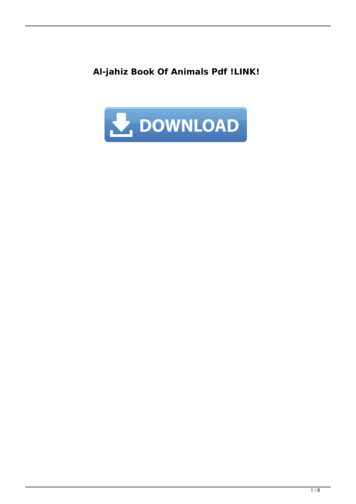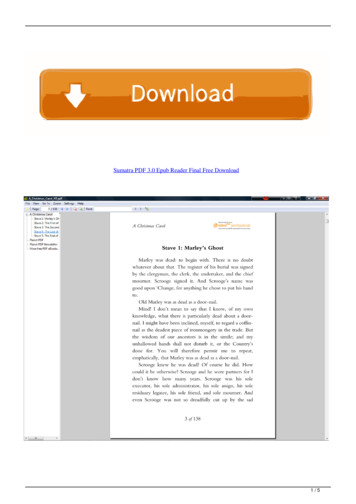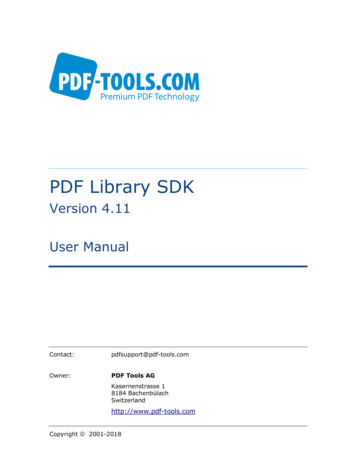
Transcription
CoursesCOURSESPDF COURSE LISTBUSINESSACC 241Intermediate Accounting II4.0 UNITSACC 121Principles of Accounting I3.0 UNITSACC 211Computerized Accounting3.0 UNITSACC 221Principles of Accounting II3.0 UNITSACC 224Federal Taxation3.0 UNITSACC 226Auditing3.0 UNITSACC 228Cost Accounting3.0 UNITSACC 240Intermediate Accounting I4.0 UNITSADM 201Materials Science3.0 UNITSADM 120Manufacturing Processes3.0 UNITSThis course is a continuation of Accounting 240, Intermediate Accounting I. It covers Long-Lived Assets, Long-Term Liabilities, Stockholders'Equity, Financial Statement Preparation and Analysis.Previous accounting knowledge is not required. The course covers the entire accounting cycle from analysis of transactions, journalizing,posting, worksheets, preparation of financial statements, closing entries, post-closing trail balance and reversing entries. Also introducedare the accounting principles as applied in the United States (GAAP). Emphasis is placed on practical applications of accounting proceduresas well as conceptual comprehension of accounting principles used in both service- and product-related businesses. Led by faculty, labhours are used to reinforce topics covered in lecture. Students also participate in group work and complete projects.An introduction to the construction and implementation of computerized accounting systems used to accurately document, record andsummarize financial information. The course emphasizes how such systems safeguard the assets of the client and ensure the integrityof the reporting system. Students will use source documents as a means of developing an information base. Students will design specialjournals and voucher systems as a means of facilitating recording functions and they will also develop a subsidiary ledger for purposes ofrecording secondary information. The course will conclude with students operating a fully-integrated computerized general ledger systemthat may be applied to the accounting needs of individuals, organizations and small business enterprises. Students will also independentlycomplete computer laboratory projects using specialized computer software.Continuation of Principles of Accounting I, emphasizing accounting applications for partnerships, corporations, and manufacturing. Asurvey of cost accounting and budgetary procedures including the preparation and use of financial information needed for managementplanning and decision-making. Led by faculty, lab hours are used to reinforce topics covered in lecture. Students also participate in groupwork and complete projects.A study of Federal Income Tax law and its practical application in the preparation of tax forms for the individual, partnerships, andcorporations.This course will cover the theory of auditing principles and standards employed by the external and internal auditor. These standardsare based on generally- accepted auditing standards and the related literature of the American Institute of Certified Public Accountants.Emphasis is on Auditing procedures.Examines cost accounting information systems; cost of materials, labor and manufacturing expenses, standards, and cost controls; directcosting and cost analysis.This course presents a balanced approach to the treatment of conceptual and procedural problems in accounting. The course explainsthe rationale behind business transactions and addresses the accounting and reporting of those transactions. The course will includediscussions of the latest developments in the accounting profession and practice.STEMThis course is an introduction to materials science. Topics include physical and mechanical properties of materials including metal alloys,plastics, rubbers, ceramics, glass, and composites. Students learn standard techniques for measuring mechanical properties includingAmerican Society for Testing and Materials (ASTM) D638 Tensile Test, ASTM D2240 Hardness Test, ASTM D5630 Ash Test, ASTM D3418Melting Point and Crystallization Point Test, ASTM D256 Impact TEST and ASTM D648 Heat Deflection Test. Hands-on laboratory sessionsreinforce topics covered during lecture.Catalog Course Description: This course covers the basic processing methods for metals and woods. Topics include hand tools and powertools, machining, joining, shaping, bending, surface preparation and finishing, Computer-Aided Drafting (CAD) and blueprint.Courses 1
CoursesSOCIAL SCIENCESAMS 135Introduction to American Studies3.0 UNITSThis course provides an introductory overview to the field of American Studies. It seeks to answer the question, ?What does it mean tobe an American? It integrates several disciplines, taking a holistic view of the American perspective. The goal is to introduce students tothe ideas and theories most closely linked to the field. These include topics in American history, philosophy, cultural studies, art, literature,political science and international relations.SOCIAL SERVICESANT 101Intro to Cultural Anthropology3.0 UNITSANT 102Introduction to Physical Anthropology3.0 UNITSThis course is an introduction to the anthropological study of the nature and functions of human culture. The course examines howdifferent cultures respond to certain needs expressed by religion, art, social organization and general patterns of life. The cultural diversityof humankind is emphasized.In this course, students examine evidence for the origin and evolution of humankind from our earliest ancestors to modern populations.This course incorporates theories and data from a host of anthropological, biological and archaeological expertise and seeks to explainhow and why human beings developed and adapted all over the world.STUDIO ARTSARC 105Intro to Computer Arts3.0 UNITSARC 106Digital Imaging3.0 UNITSARC 1153D Digital Design for Fabrication3.0 UNITSARC 107Print Design3.0 UNITSARC 109Interactive/Web Design3.0 UNITSARC 201Digital Video3.0 UNITSARC 202Digital Animation3.0 UNITSARC 280Computer Arts Portfolio and Presentation3.0 UNITSThis course provides an introductory level exploration of the Macintosh Operating System; print, interactive and time-based graphicsapplications; typography; and color theory for print, web and video. Students will also learn conceptual, historical, and theoretical aspectsof art and design made with digital media. 3 hours lecture/1 hour labThis course provides students with the necessary knowledge and techniques for the creation and manipulation of photographic digitalimages using digital cameras and scanners for input, Photoshop for editing and manipulation, and photo quality inkjet printers for output.Assignments and discussions address critical issues in contemporary digital practices.The course provides students with the foundation knowledge of the technical and creative aspects of digital three-dimensional design thatwill allow students to conceive, edit and fabricate objects using 3D scanners, 3D modeling software and 3D printers.This course will provide students with the necessary technical, conceptual and aesthetic knowledge to create effective designs for print thatcomprehensively communicate ideas through visual graphic form. Preparation of photos, graphics and text for use in layout and design willbe thoroughly addressed. The use of typography and its integration with images to communicate specific ideas and content to a desiredaudience will also be a main focus of the course. Adobe InDesign, Illustrator and Photoshop software applications will be utilized.This course will provide students with the necessary conceptual knowledge of the visual aesthetics of interactive design. Students willdesign websites that use intuitive visual layouts and interactivity to communicate information and ideas to a specific audience. The coursealso covers the basic technical skills required to prepare images and content for the web. The Adobe Dreamweaver software applicationwill be utilized in this course.Through lectures, demonstrations and project-based assignments, students will acquire knowledge of digital video preproduction,production and postproduction by studying treatment and storyboard design, lighting techniques, shot composition using high-definitionvideo cameras, editing video and sound, creating title sequences, compositing video, compressing data, and publishing digital video.Industry standard desktop video and audio editing software applications will be utilized. This course will also examine the role digital videoand moving images have played in contemporary art, documentation, and mass media. Equipment will be supplied.This course provides students with the necessary knowledge and skills to create dynamic two-dimensional digital animation and motiongraphics. Students will acquire the analytical and critical thinking skills required to conceive, produce and publish original digital animationsutilizing industry standard software applications. Students will use storyboarding, rotoscoping, animated typography, original characterdevelopment and scene production techniques. 2D animation fundamentals as well as concepts of motion and continuity will be thoroughlycovered in this course. This course will also briefly introduce 3D compositing and interactivity. Equipment will be supplied.Computer Arts Portfolio and Presentation provides student artists and designers with the knowledge to meet both their educational andprofessional goals. Students will prepare their work to be presented to both future clients and employers as well as for admission to senior2 Courses
Coursesacademic institutions. Students will acquire conceptual knowledge and technical skills to effectively present their work in many formatsincluding as a printed portfolio, a web-based portfolio, a video reel for animation and video works, an interactive video disk, in an exhibitionsetting and as a multimedia presentation to an audience. The course will culminate with an exhibition and presentation of students? work.Computer Arts Portfolio and Presentation is the Capstone course for the A.F.A. Studio Arts ? Computer Arts Option.STUDIO ARTSART 125Art History II3.0 UNITSART 103Two Dimensional Design3.0 UNITSART 106Drawing I3.0 UNITSART 107Painting I3.0 UNITSART 113Three Dimensional Design3.0 UNITSART 114Color Theory3.0 UNITSART 210Introduction to Gallery Management3.0 UNITSART 115Art History I3.0 UNITSART 116Drawing II3.0 UNITSART 220Art in Context2.0 UNITSArt History II traces the development and evolution of techniques and styles from the 15th to the 20th century. This course will cover majormovements of art including the Baroque, Rococo, Neo-Classicism, Romanticism, Impressionism, Post Impressionism, Dada, Surrealism,and Modernism. Students follow art into the twenty first-century, and view how social, technological, and spiritual changes affected itsdevelopment.Two-dimensional design introduces the organization of visual elements on a two-dimensional plane. The elements of art and conceptsof design such as composition, perspective, color and other art elements will be examined through lectures, demonstrations and relatedstudio problems for the students to explore and solve. Techniques for handling materials will be developed.This is an introductory course in basic drawing skills. Emphasis is on drawing from direct observation or life with a variety of traditionaldrawing materials and techniques. It includes an introduction to various systems of drawing - e.g., linear perspective and principles ofchiaroscuro.This course is an introductory studio (laboratory) course in basic painting skills and techniques. Focus will be upon the use of paint to createfine art and explore individual creative potential. Emphasis will be on control and proficiency in handling the medium of paint and learningthe fundamental painting techniques. This course is designed for beginners with little or no experience of painting. Proficiency in drawingis beneficial but not critical to successful completion of the course.Student artists will learn to create practical and theoretical three- dimensional objects using a variety of techniques and materials. Throughthe study of nature and geometry, students will learn to use line, plane, mass, volume and surface.Color theory teaches student artists how color affects the human brain, psyche, emotion and eye. Through lecture, multimediapresentation, and hands-on studio assignments, they learn how color functions with light, computers, and pigment.Introduction to Gallery Management introduces students to the hybrid nature of arts-related careers including museum education,curatorship, arts administration, and operating commercial galleries. Students gain first hand experience in the day-to-day galleryexperience working in the Benjamin J. Dineen, III and Dennis C. Attachment II Hull Gallery and demonstrate the scholarship, productionand marketing skills necessary for the successful creation of an art exhibition and/or sustained gallery program. The material coveredin Introduction to Gallery Management provides students with a general model of how art galleries function as cultural institutions thatcollect, display and interpret art and objects. Topics include the history of art display and art exhibition education and students explorecuratorial practice within the vast range of gallery and museum exhibition spaces. The course provides practical experience for studentsinterested in pursuing a career in the visual arts. As students engage with the course material they also develop and enhance their skills invisual and verbal literacy, self-expression, creative problem solving, writing, and critical thinking. The course material is complemented byfield trips to museums and galleries in New York and New Jersey. Students will complete independent work as a docent at the Benjamin J.Dineen, III and Dennis C. Hull Gallery for twelve hours over the course of the semester.Art History Part I traces the development of art from prehistory through the early Renaissance. The course surveys the major developmentsin painting, drawing, sculpture, ceramics and architecture through the western canon and provides an introduction to the art of Africa, theNear East, South and Southeast Asia, China and Japan.A continuation of Drawing I, this course will focus on individual development, a thorough understanding of drawing principles and furtherthe use of drawing materials and techniques. Students are responsible for the purchase of their own supplies.ART 220 is a co-requisite course to ART 130 and ARC 280 enables students to identify and research major trends in visual arts and theircultural and historical context through first-hand experience. Students develop a deeper understanding of the contemporary art worldthrough increased engagement and familiarity with various New York and New Jersey art institutions. Students visit museums, galleries,art fairs, artist and design studios, auction houses, conservation studios and attend artist lectures to experience and better understandcontemporary art and the structure of the contemporary art world.Courses 3
CoursesART 117Painting II3.0 UNITSART 130Portfolio and Presentation3.0 UNITSART 120Survey of Contemporary Art3.0 UNITSART 127Water Color3.0 UNITSART 101Experiencing Art3.0 UNITSART 126Figure Drawing3.0 UNITSA continuation of Painting I, this course is an advanced studio painting class stressing individual painting skills and personal style. PaintingII focuses on compositional theories and practice, experimentation with mediums, and creative approaches to subjects. Students areresponsible for the purchase of their own supplies.Portfolio and Presentation will provide student artists with the knowledge and skills to meet both their educational and professional goals.First, student artists will develop a physical and digital portfolio showcasing their best works created at HCCC. This will allow students toseamlessly enter the third year of any four-year art program. Second, student artists will learn to market themselves to clients, museums,and galleries. A resume, artists statement, PowerPoint presentation, slide packet and web site will be produced. New technologies will bestressed along with traditional (non-digital) methods to prepare the student for the professional art world.Survey of Contemporary Art examines the development of the formal and conceptual concerns that have shaped 21st Century art.Distinguished by the absence of a uniform organizing principle or label, contemporary art is a diverse and eclectic combination of subjects,concepts, materials, and methods. Students explore the notion of what art is and how it can be made through the consideration of ideas,practices and concepts that are unique to our contemporary world.In this course, students will learn through demonstration and experience how to paint using the medium of watercolor. Students will createstill life, landscape (out of doors, weather-permitting), figurative, and abstract paintings. Students who successfully complete this coursewill possess a basic painting kit, a portfolio of watercolor paintings, and the fundamental knowledge and basic skills needed to effectivelyuse the medium.This course is designed as an introduction to the Studio Arts for non-art majors. Students will learn through the basic theories and practicesof Art History, Drawing, Painting, Printmaking, and Sculpture.Student artists will learn to draw the nude and clothed male and female form. Emphasis is placed on scale, proportion, anatomy, expressionand appreciation of the figure.HUMANITIESASL 101American Sign Language I3.0 UNITSASL 102American Sign Language II3.0 UNITSBIO 270Cell Biology4.0 UNITSBIO 260Molecular Biology4.0 UNITSBIO 100General Biology3.0 UNITSASL 101 is an introductory course to American Sign Language as it is used within the American Deaf community, as well as an introductionto Deaf Culture and history. The class will emphasize non-verbal communication as students learn basic vocabulary, sentence structure,facial expressions, signing parameters and other grammatical markers. Students will start to build basic expressive and receptive skills inAmerican Sign Language that will be reinforced by a variety of activities.ASL 102 is a second level course in American Sign Language as it is used within the American Deaf community, as well as a continuationof discussion of Deaf Culture and history. The class will emphasize non-verbal communication as students continue to build their signvocabulary, sentence-structure, facial expression, and other grammatical markers. Students will continue to strengthen their expressiveand receptive skills in American Sign Language as they engage in conversations that will be reinforced by a variety of activities. Contentfrom ASL 101 will be continually reviewed and built on in this course.BIOLOGYThis course is a study of the mechanisms occurring within the cell. It is an overview of the structure and function of eukaryotic cells. Itreviews in depth the organization of the cell plasma membrane and organelles. The physiology of each cell component is further detailed.This Course is designed to give students a comprehensive understanding of the function and structure of nucleic acids and proteins incells. Students learn various cell signaling pathways including protein transport, protein activation, apoptosis, and cell cycle control inboth Eukaryotic and Prokaryotic Cells. Students also learn various Molecular Biology laboratory techniques including gene expression,recombinant DNA technology, Chromosome mapping, Protein and RNA extraction. AttachmentThis is an introductory course in contemporary biology designed to provide a foundation for further studies in biology. Instructionaltechniques include lectures, demonstrations and laboratory.4 Courses
CoursesBIO 107Human Biology4.0 UNITSBIO 111Anatomy and Physiology I4.0 UNITSBIO 116Principles of Biology II4.0 UNITSBIO 201Practical Nutrition3.0 UNITSBIO 208Ecology4.0 UNITSBIO 211Anatomy and Physiology II4.0 UNITSBIO 230Histology4.0 UNITSBIO 250Microbiology4.0 UNITSBIO 240Genetics4.0 UNITSBIO 120Human Sexual Biology3.0 UNITSBIO 115Principles of Biology I4.0 UNITSMolecular Biology4.0 UNITSThis course focuses on an understanding of the biological functioning of humans. Additional emphasis is given to genetics, ecology andmicrobiology. Laboratories include hands-on exercises and lab dissections.This course examines the structure and physiological processes of the human body and provides a background for understanding healthproblems, diagnosis, and treatment.This course is a continuation of Principles of Biology I. Students will study the structure, function, and behavior of organisms and the unityand diversity of life. They will learn about biological organisms and processes and how to correlate new biological concepts with the onespreviously learned. Laboratory exercises will encourage students to practice science through hands-on experiments.This course stresses the application of nutritional principles to daily health maintenance and conditions that require special dietmanagement. It is designed for Nursing and Health-related or Culinary Arts/Hospitality Management programs.In this course, students will understand the mechanisms governing the structure and function of ecological systems, particularly therelationship between organisms and the environment. Students will investigate key environment issues such as; global climate change,acid deposition, loss of biodiversity and genetically modified food.This course is a continuation of Anatomy and Physiology I. Students will become acquainted with the basic functions, complexities,and inter-relationships of the components of the human body. Topics will include the circulatory, endocrine, digestive, excretory, andreproductive systems. Lectures are supplemented by laboratory sessions which will include dissection and elementary physiologicexperiments.In this course, students will recognize the structure and function of cells, tissues, and organs at the microscopic level. They will identify andrecognize all of the major cell and tissue types of the human body. Histology is a laboratory course and lectures often take the form ofslide demonstrations. The lab and lecture will be combined into a single learning experience.This course is geared for individuals entering the medical or health sciences professions. It will encompass a survey of microorganisms withemphasis on bacteria and applications of microbiology. The laboratory sessions will stress isolation, cultivation, and various biochemicaland identification techniques of selected bacteria and other microorganisms.This course examines the principles of inheritance and gene action, from the molecular to the organism level, and populations. Topicsinclude Mendelian principles, molecular genetics, genetic mapping, population generics, quantitative genetics, gene regulation, mutations,repair mechanisms, and the modern genetic manipulation.This non-lab science course is designed for liberal arts and other non-science majors. It gives students the opportunity to discover andunderstand the major biological aspects of human sexuality. It focuses on the anatomical and physiological study of the reproductivesystem, conception process, pregnancy period, prenatal development and delivery stages, sexual maturation, gender distinctiveness,and the infectious maladies and specific medical conditions associated with human sexuality. Video simulations in selected topic areincorporated to reinforce scientific exploration and formulation.Biology is a vast subject that explores all of life, from molecules to ecosystems. Students will acquire a framework of key biological conceptsinto which they can fit the many new things they will learn. They will become familiar with the scientific process, in particular, the posingand testing of hypotheses, and the scientific study of life, evolution, ecology, plants, and animal forms and functions. Laboratory exerciseswill encourage students to practice science through hands-on experiments.BIOLOGYBTN 201This Course is designed to give students a comprehensive understanding of the function and structure of nucleic acids and proteins incells. Students learn various cell signaling pathways including protein transport, protein activation, apoptosis, and cell cycle control inboth Eukaryotic and Prokaryotic Cells. Students also learn various Molecular Biology laboratory techniques including gene expression,recombinant DNA technology, Chromosome mapping, Protein and RNA extraction. AttachmentCourses 5
CoursesBUSINESSBUS 103Introduction to Business3.0 UNITSBUS 205Global Business3.0 UNITSBUS 299Business Internship3.0 UNITSBUS 230Business Law3.0 UNITSThis is an introductory course in contemporary business practices. Students develop a basic understanding of key functional areas ofbusiness including management, marketing, finance, economics, accounting and technology. The course focuses on current dynamic issuesfacing business such as globalization, entrepreneurship, ethical reasoning and the legal/regulatory environment.The course provides a broad overview of international/global Business highlighting the opportunities and challenges multinationalorganizations face in today's dynamic environment. Students are introduced to the cultural, economic, political, competitive and legalenvironments in which international/global businesses operate.This course provides the student with on-the-job business experience. The course allows the student to gain supervised practical experienceworking in a setting related to the student's area of business interest. Students must successfully complete 225 hours of practical experiencein an approved business workplace. There is an additional lecture component for students to share their experience and discuss lessonslearned.Provides a basic knowledge of business law covering the nature, structure and processes of our legal systems and the laws involvingconstitutional law, contracts, intellectual property, torts, and product liability. The case study approach will be used extensively, and theethical issues in the business environment will also be addressed throughout the course.CULINARY ARTSCAI 115Food Sanitation and Culinary Principles3.0 UNITSCAI 114Tableservice I2.0 UNITSCAI 117Production Kitchen Skills I2.0 UNITSCAI 118Pantry and Breakfast Cookery2.0 UNITSCAI 119Bakeshop I2.0 UNITSCAI 124Tableservice II2.0 UNITSThis course introduces students to the principles of conduct and employment in the food service industry, coupled with sanitationconcepts in the operation of a food service establishment. Professionalism, ethics, conduct, and employment opportunities during andafter completion of a degree are discussed. Personal hygiene, fire safety regulations, including state and federal laws pertaining to thehandling of food products are studied. This course prepares students for a nationally recognized ServSafe certification exam provided bythe National Restaurant Association Educational Foundation (NRAEF)An introduction to the various types of table service styles and settings, including American, French, Russian, banquet, and family style.Emphasis is placed in proper dining room preparations, customer relations, placing and retrieving orders, clearing of tables, and securingthe dining room. Students will also be exposed to the role of the dining room in the overall business plan of the restaurant business. Thecourse also covers an introduction of wines and wine making.This course is intended to provide a strong foundation in the basic fundamentals of commercial food preparation and practices. Properknife skills and the use and care of tools and equipment is demonstrated and practiced in the laboratory. Emphasis is placed withstudents using hands-on experience in food production utilizing designed introductory menus. The hands-on experience is supported withdemonstrations and lecture in the laboratory. Students will learn the appropriate cooking methods that may be applied to meats, fish,poultry, starches, and vegetables. The basic cooking methods are introduced and practiced in the laboratory. Students will also learn theproper techniques used in the preparation of stocks, soups, and sauces.An introduction to the basic and advanced level of breakfast cookery, including basic egg preparations, breakfast meats, potatoes, quickbreads, batters, various breakfast items, farinaceous and hot and cold cereals. Students will experience short order cooking, and will gainknowledge of time and temperature in the preparation of various breakfast items. Skills and techniques will be developed in the preparationof meat products, such as sausage-making, and in the preparation of other breakfast meats. Ethnic and multicultural breakfast foods willbe explored, as well as creative and modern breakfast alternatives. This course also serves as an introduction to the preparation of varioussalads, including simple, composed, bound, and hot/cold combinations. Emphasis will be on the preparation of dressings, dips, spreads,classical and modern sandwich-making, identification and use of salad greens, and fruit preparations.An introduction to the preparation of basic quick breads, rolls, breakfast items, and basic desserts, including various icings and buttercream, puddings, cakes, cookies, and pies. Students will gain skills in the preparation of pie crusts, pie washes, and pie fillings. Emphasiswill be placed on the understanding and use of ingredients, weights and measures, tools, and equipment used in the bakeshop.An extension and reinforcement of the skills practiced in Table Service I. Emphasis is placed on knowledge of the menu, suggestive sellingtechniques, napkin folding, and the use of wines and spirits in the restaurant business. Banquet service will be performed through adesigned and scheduled buffet.6 Courses
CoursesCAI 125Externship I1.0 UNITCAI 127Production Kitchen Skills II2.0 UNITSCAI 128Introd
ANT 101 Intro to Cultural Anthropology 3.0 UNITS This course is an introduction to the anthropological study of the nature and functions of human culture. . Industry standard desktop video and audio editing software applications will be utilized. This course will also examine the role digital video and moving images have played in .











